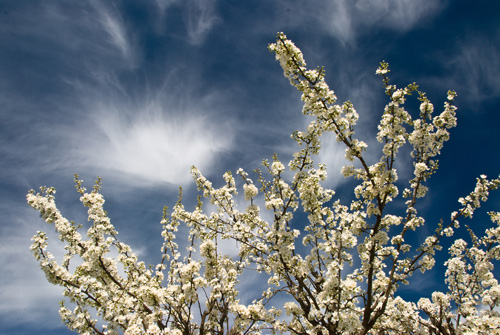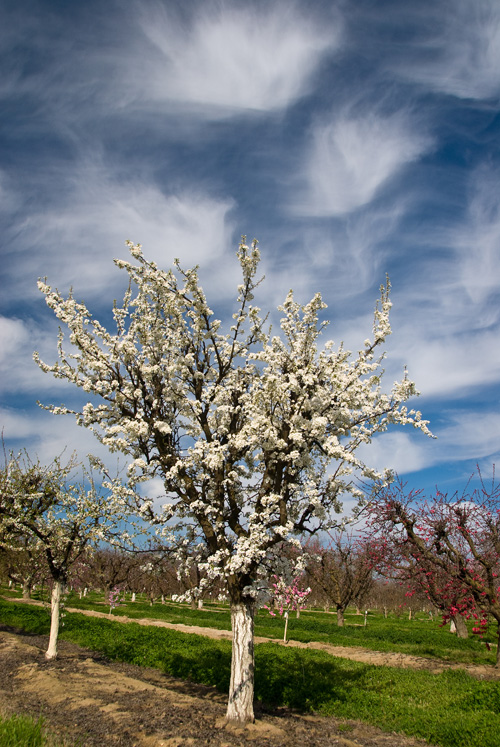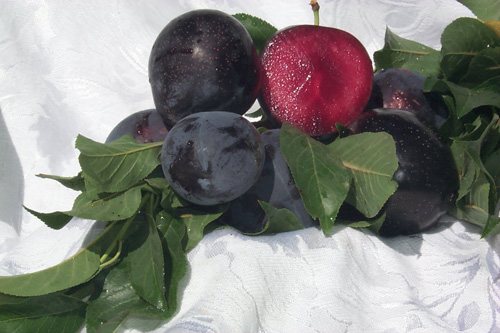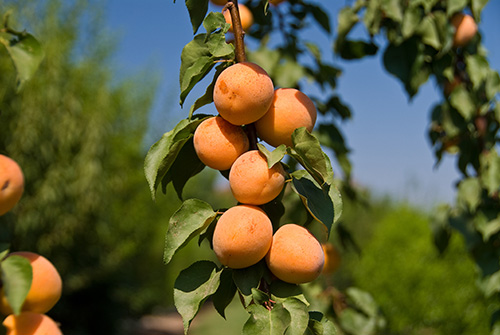Ron Ludekens
Remove Fruit from a Young Tree?
Question: i planted the peach and pear trees (two of each next to each other) last week. they now have pea size fruits on them. my husbands friend said to pick these off the first year. Is this right? why or why not?
PLEASE Peggy - Colorado City, TX
Answer: If I were you, I would follow your friends' advice. Right now you are most concerned about getting your tree well established. Good growth to the roots and then to the top. Prune and shape so it will have branching for the future that is easy to reach and pick. Production of fruit takes a lot of the tree's energy and you want all that energy for root development and top development. I would take off that young fruit this year for sure and even consider it next year too depending on how well the tree gets established.
Ron L.
Cooke's Purple Wisteria - Size
Question: Hello- I am writing to you with a question about L.E. Cooke Co.'s Purple "Cooke's Special" Wisteria. My question: What is the expected mature height and width of this plant? I am about to install one of these plants in the garden of my home in Phoenix, Arizona. If you can help in answering my question, I'd certainly appreciate it. Thank you.
Sincerely, Tom
Answer: Hi Tom,
Good choice of wisteria! The spring blossoms are stunning and the summer re-bloom is what makes this special selection so popular.

Cooke's Special Purple Wisteria Spring Bloom

Summer Re-Bloom of Cooke's Special Purple Wisteria (July 4th photo)
Your size question needs more than a simple answer. Wisteria is a vine and is only controlled in size and shape by you. There is no mature height and width - it all depends upon what you allow it to climb on and how far before cutting it back. The city of Sierra Madre, CA just finished celebrating their annual wisteria festival around a 100 year old wisteria vine with the following from a news report: "The masterpiece wisteria vine growing in California is so large that it has received a place in the 'The Guinness Book of Records'. It has been named as "The largest blossoming plant in the world." This amazing wisteria vine is more than one acre in size and weighs 250 tons. It has more than 1.5 million blossoms every year with 40 blooms per square foot. The branches of this unbelievable wisteria vine reach an amazing 500 feet long." In other words - the vine can get BIG. Or you can prune it to the size you want.
Here are some of my photos from a neighbor's home where several vines cover a huge back patio - notice the support and size of the trunks. They are gorgeous.

Three vines cover this long patio

Cooke's Special Purple Wisteria on a well built patio just for the purpose of showing off this vine.
Like many vines they can take over things. I have seen wisteria completely take over trees so care needs to be taken where you allow it to climb. Very beautiful until it kills the tree!
Enjoy your vine. They are beautiful.
Ron L.
Flowering Apricots for Burbank, CA
Question: I was wondering will Prunus Mume 'Rosemary Clarke' do well in my area? I think we get about 350 chill hours a year.
Nanthawat, Burbank, CA

Rosemary Clarke Flowering Apricot
Answer: Absolutely! All the Flowering Apricots (Prunus mume) require only 100 to 150 hours of chilling. A good choice for your area. See more details: Flowering Apricots
Fig Dropping Leaves
Question: I was given a dwarf fig tree for Christmas sent from you. It has been growing beautifully up until a couple of weeks ago. It has been in my sun room the whole time. The leaves are getting splotchy and one is almost completely yellow, and just fell off. I don't know what to do!! Help me please. Janice, Pagosa Springs, Colorado.
Answer: Your question raises a lot of other questions. Since we do not sell retail, I doubt if we sent the fig directly to you. You must have received if from some other source with our tags on it. If it came from us at Christmas, it would have been bareroot and no leaves on it.
One big possibility: Figs are deciduous - meaning it goes dormant in the winter and loses its leaves - at least the kind we grow. Normally this happens with colder days and shorter nights. If you received it around Christmas with leaves on it, that means it did not yet go dormant and it wants to. Losing leaves is normal and it will be leafless for a month or two before re-leafing.
Another possibility - figs are very water sensitive. Do not over water! Since I do not know what you got or from where - those are my best guesses.
Pink Perfection Flowering Crabapple
I have a favorite Flowering Crabapple. When it is in bloom, in my mind nothing compares to it.

Pink Perfection Flowering Crabapple
The Pink Perfection Flowering Crabapple out shines every other tree in our budwood orchard when it is in full bloom. It glows.

This Crabapple is not for everyone or every climate. There is a drawback to the Pink Perfection Flowering Crabapple. It gets scab badly. But that is only an issue of concern if scab is a problem you fight in your area. It is rarely a problem in the arid west. If you do not get scab in your area, I highly recommend this tree.

We have fire blight in our climate and we have not had to spray the Pink Perfection trees as they have not shown any detrimental effects. I hope you give this winner a try.
Ron L.
Showy Spring Bloom on Burgundy Plums
 Burgundy Plum Spring Bloom
Burgundy Plum Spring Bloom Everyone first notices the unusual (for us anyway) formation of the clouds in this photo.
 Burgundy Plum Bloom (and pruned hard for budwood - not fruit)
Burgundy Plum Bloom (and pruned hard for budwood - not fruit)
What is not unusual is the yearly, stunning white bloom of the Burgundy Plum. Most of us only think of the edible plums for their summer fruit and forget about the attractive spring bloom. The Burgundy Plum has one of the nicest. Again you get two seasons with one tree.

The Burgundy Plum is one that nearly every nursery should sell. It is an excellent tasting, red fleshed Japanese Plum which for us ripens over a long period from Early July until late August and sometimes into early September.
Burgundy Plum is self fertile which eliminates the need for a pollinizer in the small yards of many homeowners. In my opinion, it tastes just as good if not better than the old favorites of Mariposa and Satsuma Plums - each of which requires a pollinizer to fruit.
It has a wide climate range too. Needing less than 350 hours of winter chilling allows this plum to be used in the many of populous coastal areas of our country. It is also fairly cold hardy, comfortable going into USDA Zone 7 and probably into Zone 6.
Every nursery should carry at least two varieties of edible plums - one being red skinned with amber flesh (like Santa Rosa, Methley, Beauty) and the other a red skinned, red fleshed plum like Burgundy.
Ron L.
Spring Has Sprung!
At last! The long days and nights to finish the 2010-11 catalog are over. It is at the printer's and we will begin mailing it out this week. Now I have a little more time to enjoy the blessings of spring.

Prairifire Flowering Crabapples and California Poppies outside my office window (trying unsuccessfully to hide the irrigation pumps)
The last 2 weeks the sales staff spent a lot of time in our annual training. Part of their annual training is walking through the scion wood orchard next to the office.

Rosie next to Helen Borchers Flowering Peach

Lloyd also under Helen Borchers Flowering Peach

Denise enjoying the early blooming Excel Lilacs (where is my Claritin?)
We spent a little extra time looking at the flowering crabapples - most of which are in glorious bloom. Over the years crabapple sales have declined not only for us but for most growers as well. I keep wondering where the sales went.
It is a shame. Crabapples are some of the prettiest trees in our orchard each spring. Do landscape architects only know about Flowering Pears and Plums? California has always been weak on crabapples, but even the strong market in the Midwest seems to have slowed dramatically. If you have any ideas to share, post a reply to this article for all to see.

I have a favorite. The Pink Perfection is absolutely stunning each Spring. I can see it in the orchard from miles away - it nearly glows. You can read more about it here: Pink Perfection Flowering Crabapple
Hope you have a wonderful spring!
Ron L.
Spring Time - in the Dark
What's wrong with me? This has become one of the most beautiful springs with desperately needed storms creating dramatic, picturesque skies and the blossoms bursting out all over - and here I am missing it all!

Red Baron Fruiting/Flowering Peach - Illuminated by flash
It is the time of the year where I am hunkered down in the office day and night wrapping up this season and preparing for next season. Heavy time is spent working on next year's catalog plus shipping out a few late season trucks.
Truth be told, I would really rather be in the orchards, camera in hand taking pure delight in the beauty around us - and sharing it with you.
So Monday, I took a sanity break late in the day and zipped out into the orchard next to the office. Should have gone earlier because I was losing the light fast and another rain maker was about to unload on us.
You will notice the trees in our scion wood orchard look rather harshly pruned - and not very photogenic. That is because we cut them hard so the trees put out a lot of new vegetative growth to be used as bud wood and cutting wood for propagation. It is necessary to do, but frustrating to the photographer in me as I really want to show full trees - not just closeups of fruit and flowers.

Saturn Fruiting and Flowering Peach in full, long lasting bloom
Monday evening, I saw this Saturn Peach in full bloom. This tree had been flagged not to cut just so I could take better photos this year. Looks like I waited a bit too long - the blossoms are already beginning to drop after 2-3 weeks of bloom. And it was about to rain.

Saturn Fruiting & Flowering Peach in Bloom - the first of two seasons
Saturn Peach is one of my favorites. Stunning, long pink spring bloom and very good peaches in July. I love a tree that can offer two great seasons - a dual purpose tree.

Saturn Peach Bloom
Next to this Saturn Peach was one of the Red Baron Peaches (seen above in first photo when it was getting really dark). It was pruned heavily (butchered?) as we usually do for the Budwood Orchard trees. None the less, the photo still gives a hint of its magnificent spring blossoms. The fruit on this tree is excellent - one of the best in my opinion.
If you had room in your yard, I would plant one of each for these dual season trees.
Three Blueberries in a Whisky Barrel
Question: can I put 3 blueberry plants into one half whisky barrel, as your vendor said it would be ok?.they are a northblue, southmoon, sunshine blue. Thank You.
Gil - Coos Bay Oregon
Answer: Yes - but I wouldn't.
I like the idea of blueberries in large containers. Here is what I like about the idea. You can control the planting media. Blueberries love acidic soil in the 4.0 to 5.5 pH range. Many of us have native high pH soils that make that difficult to reach. But with proper planting media you have complete control over that. I also like the ability to roll a container to different locations during different seasons - into the shaded areas for blueberries in our very hot summers (something you don't have to worry about).

Southmoon Blueberry
I also like your selections. You have two mid-season ripening blueberries (Northblue & Sunshine Blue) and one mid to late season variety (Southmoon) giving you a range of ripening. If the choice was available, I would have tried for an early season selection as well. I also like that the multiple selections will cross pollinate each other which provides for an increased crop since those blueberries are only semi self-fertile.
The concern I have would be mature plant size of three plants in one whisky barrel. Northblue is your smallest plant reaching 2-3 feet in size. The Sunshine Blue is also a small grower of 2-3 feet (and it remains semi-evergreen). Southmoon reaches a size of 5-6 feet. You will be doing some creative pruning to keep them in balance without the larger plant taking over. I might suggest using two barrels and put the two smaller plants in one the the larger growing blueberry in the other.
For further reading on blueberries: Success with Blueberries.
I hope you enjoy your delicious crops and save a blueberry muffin for me!
Ron L.
Low Chill Apricot
Question: My area has (on avg) about 350 hours per year of winter chill. I have been dissapointed in my Katy Apricot (no fruit) and my Blenheim Apricot (occasional fruit) over the last few years. What is your most reliable apricot for mild winters? Ed - Somis, CA
Answer: Ed,
We have a recommended variety for you. In fact it came from a nurseryman near you in Camarillo that had the exact same problem. He had this chance seedling that fruited every year in his yard when Blenheim often did not. We grew it for a number of years and then named it Tropic Gold® Apricot when we produced the trees for selling.

Tropic Gold® Apricot
I have been impressed by its productiveness. In fact, the branches will weep with the fruit load.

Tropic Gold® Apricot so loaded it weeps!
You can see more information on this information flyer here: Tropic Gold Apricot and additional photos on my photography website here: Tropic Gold Photo Gallery
You should find it in some of your local retail nurseries - just ask for it by name.
Ron

